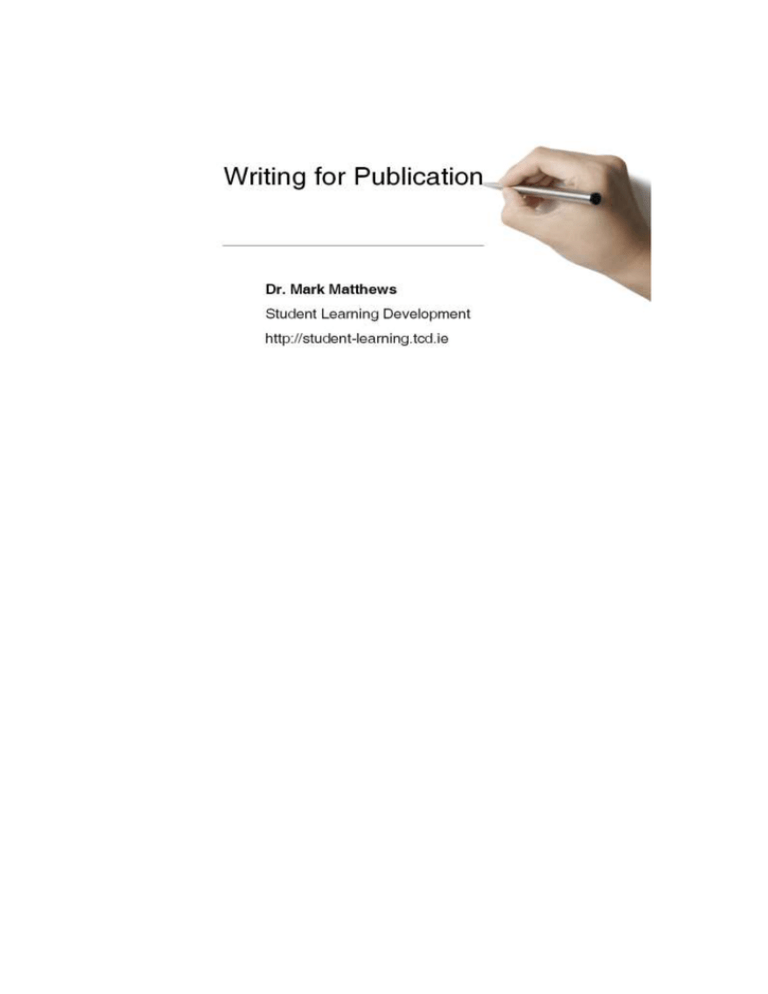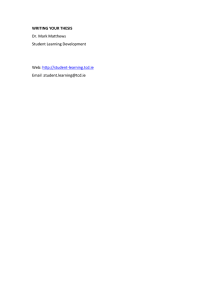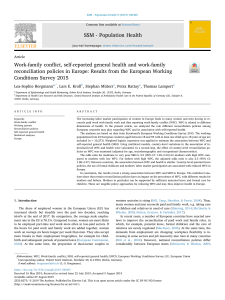Writing for Publication Handout - (MS Word 255kb)
advertisement

WRITING A MESSAGE SENTENCE An effective document delivers a single main message. The message is your document's governing idea. Everything else - the other ideas, the information to support them, how it is all ordered, how you present the material - depends on that message. Your message isn't a title or an explanation of what you are doing in the document. It is the single most important point you need to make to express your purpose. This involves: Constructing the message Checking and improving the message Constructing the message I want this paper to…… Now, think about your primary readership. Who are they? What do they expect? Which key persuasive factors do you think will most strongly influence them? Imagine this situation. You are holding a conversation with the primary readers. It is the start of the conversation and greetings have been exchanged. They have no idea what you are about to talk about. They're waiting for you to say something interesting. What would you say? Write down in a single sentence the most important point you want to make. Now, look at the sentence you have written. Is this what you would say to the primary readers, face-to-face? Would it make sense to them, on its own? Is it appropriate? Would they be interested? Your message should be the kind of sentence that would grab the readers' attention and force them to keep listening. It should also summarise everything else you want to say. (It's best, therefore, for the message not to be a question, or for it to consist of question and answer.) If you were suddenly forced, at this point in the conversation, to stop talking, your sentence should have said the most important thing you needed to say to your primary readers. This is not as easy as you may think. Don't expect to create the right message immediately. You may need to try a few times before you write a message that is satisfactory. Writing Your Abstract SPSE Technique This technique sometimes referred to as SPQR (Situation-Problem-QuestionResponse), can be useful at the early stages of your paper. Complete one paragraph for each heading. Situation: Describe the general background / setting in which your research takes place Problem: Describe a problem that the research addresses. Solution: What did you do or try to address this problem? Evaluation: How did you evaluate the proposed solution and what were the results? Robert Brown’s Eight Questions These questions can be used as prompts when you are planning your paper. Authors (in order of appearance) Anticipated Journal: 1. Who are the intended readers? (name 3-5) Give their names and why they should be interested 2. What did you do? (50 words) Briefly outline the methods you used to gather evidence. 3. Why did you do it? (50) Briefly outline the problem you are tackling and why it is important. 4. What happened? (50) Briefly outline the key results. Focus on outcomes. 5. What do the results mean in theory? (50) Think about how your results and conclusions will change how people see the world. 6. What do the results mean in practice? (50) Superior research also has practical consequences. What are the consequences of your work? Think about how your results and conclusions might change what people do. 7. What is the key benefit for readers? (25) 8. What remains unresolved? (50) This is more for your own benefit, but will provide some guidance for your audience and some of it may be useful in your discussion. References Brown, R. (1994) The ‘Big Picture’ about Managing Writing. In O. Zuber-Skerrit and Y. Ryan, (Ed) Quality in Postgraduate Education Ch 8 , pp90-109, Kogan Page : London Brown, R. (1994) How to focus your reader with the ‘main message’. In L Conrad (Ed) Developing as Researchers. Griffith Institute of Higher Education, Griffith University, Queensland. Writing for academic journals / Rowena Murray WRITING AN ABSTRACT 4 C’s Complete - it covers the major parts of the project Concise - it is focussed and provides clear information on the topic Clear - it is readable, well organised, and not too jargon-laden Cohesive - it flows smoothly between the parts Avoid generic statements like: “The results we be discussed” “Methods are presented” “Future research is discussed Abstract Structure TITLE: Aim Background Objectives Method Main results Findings Conclusions Outline Papers reporting empirical data Source: http://www.idrc.ca/IMAGES/books/WFC_English/WFC_English//sitemap.html To be accepted for publication your paper must present data in a way that allows other experts in your field to: Assess your observations; Repeat your experiment (or judge its validity); Evaluate the intellectual processes. For this reason, papers that report on empirical data have a standardised structure. They are also usually written in a highly stylised and distinctive way Such papers usually contain four sections: Introduction Materials and methods Results Discussion Some journals may permit some variations of this structure. However, the content is always the same. We suggest that you prepare an outline for each section. Although the Introduction will eventually be the first part of the paper, our advice is to leave preparing the outline of the introduction to the end. Many people do it that way, which is why introductions are often referred to as 'post facto justifications for what follows'. RESOURCES www.phrasebank.manchester.ac.uk (a general resource for academic writers with academic phrases etc.) http://successfulacademic.typepad.com/ writing blog, tips Murray, R (2009) Writing for academic journals, 2nd edn. Maidenhead: Open University Press-McGraw-Hill. Murray, R & Moore, S (2006) The handbook of academic writing: A fresh approach. Maidenhead: Open University Press-McGraw-Hill (chapter 7). IDRC website with a lot of really useful tips on academic writing http://www.idrc.ca/IMAGES/books/WFC_English/WFC_English//sitemap.html UniLearning: an excellent resource on high (e.g. critical thinking, structure) and low level (e.g. paragraphs, sentence structure) aspects of academic writing: http://unilearning.uow.edu.au/main.html Freewriting: Elbow, P. (1973) Writing without teachers. Oxford: Oxford University Press Referencing Guide to Referencing in Nursing: http://www.tcd.ie/Library/support/subjects/nursingmidwifery/Harvard%20Ref%20System%202009-2010.pdf Library Video on Referencing: http://www.tcd.ie/Library/support/referencing.php Cite2Write Website: http://www.cs.qub.ac.uk/emm/10170987/cite2write/




